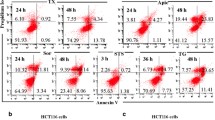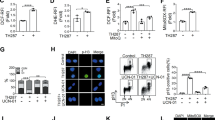Abstract
Mimosine, a non-protein amino acid, is mainly known for its action as a reversible inhibitor of DNA replication and, therefore, has been widely used as a cell cycle synchronizing agent. Recently, it has been shown that mimosine also induces apoptosis, as mainly reflected in its ability to elicit characteristic nuclear changes. The present study elucidates the mechanism underlying mimosine’s apoptotic effects, using the U-937 leukemia cell line. We now demonstrate that in isolated rat liver mitochondria, mimosine induces mitochondrial swelling that can be inhibited by cyclosporine A, indicative of permeability transition (PT) mega-channel opening. Mimosine-induced apoptosis was accompanied by formation of hydrogen peroxide and a decrease in reduced glutathione levels. The apoptotic process was partially inhibited by cyclosporine A and substantially blocked by the antioxidant N-acetylcysteine, suggesting an essential role for reactive oxygen species formation during the apoptotic processes. The apoptosis induced by mimosine was also accompanied by a decrease in mitochondrial membrane potential, cytochrome c release and caspase 3 and 9 activation. Our results thus imply that mimosine activates apoptosis through mitochondrial activation and formation of H2O2, both of which play functional roles in the induction of cell death.






Similar content being viewed by others
References
Kristen NSK, Vulliet P (1996) Mimosine blocks cell cycle progression by chelating iron in asynchronous human breast cancer cells. Toxic App Pharm 139:356–364
Dewreede S, Wayman O (1970) Effect of mimosine on the rat fetus. Teratology 3:21–27
Kalejta RF, Hamlin JL (1997) The dual effect of mimosine on DNA replication. Exp Cell Res 231:173–183
Soedarjo M, Borthakur D (1998) Mimosine, a toxin produced by the tree-legume Leucaena provides a nodulation competition advantage to mimosine-degrading Rhiobuim strains. Appl Environ Microbiol 30:1605–1613
Krude T (1999) Mimosine arrests proliferating human cells before onset of DNA replication in a dose-dependent manner. Exp Cell Res 247:148–159
Dai Y, Gold B, Vishwantha JK, Rhode S (1994) Mimosine inhibits viral DNA synthesis through ribonucleotide reductase. Virology 205:210–216
Wang Y, Zhao J, Clapper J, Martin LD, Du C, Devore ER et al (1995) Mimosine differentially inhibits DNA replication and cell cycle progression in somatic cells compared to embryonic cells of Xenopus laevis. Exp Cell Res 217:84–91
Gilbert DM, Neilson A, Miyazawa H, dePamphelis ML, Burhans WC (1995) Mimosine arrests DNA synthesis at replication forks by inhibiting deoxynucleotide metabolism. J Biol Chem 270:9597–9606
Wang G, Miskimins R, Miskimins K (2000) Mimosine arrests cells in G1 by enhancing the levels of p-27Kip1. Exp Cell Res 254:64–71
Mosca PJ, Lin HB, Hamlin JL (1995) Mimosine, a novel inhibitor of DNA replication, binds to a 50 kDa protein in Chinese hamster cells. Nuc Acids Res 23:261–268
Lin H, Falchetto R, Mosca PJ, Shabanowit J, Hunt DF, Hamlin J (1996) Mimosine targets serine hydroxymethyl transferase. J Biol Chem 271:2548–2556
Park MH,Wolff EC, Folk JE (1993) Hypusine. Its post-translational formation in eucaryotic initiation factor 5A and its potential role in cellular regulation. Biofactors 4:95–104
Hanauske-Abel HM, Park MH, Hanauske AR, Popowitz AM, Lalande M, Folk JE (1994) Inhibition of the G1-S transition of the cell cycle by inhibitors of deoxyhypusine hydroxylation. Biochem Biophys Acta 122:115–124
Panopoulous A, Harraz M, Engelhardt JF, Zandi E (2004) Iron-mediated H2O2 production as a mechanism for cell type-specific inhibition of tumor necrosis factor α-induced but not interleukin-1β induced IκB kinase complex/nuclear factor-κB activation. J Biol Chem 280:2912–2923
Mikhailov I, Russev G, Anachkova B (2000) Treatment of mammalian cells with mimosine generates DNA breaks. Mut Res 459:299–306
Crompton M (1999) The mitochondrial permeability transition pore and its role in cell death. Biochem J 341:233–249
Halestrap AP, McStay GP, Clarke SJ (2002) The permeability transition pore complex: another view. Biochimie 84:153–166
Kroemer G, Reed JC (2000) Mitochondrial control of cell death. Nat Med 6:513–519
Gogvadze V, Orrenius S, Zhivotovsky B (2006) Multiple pathways of cytochrome c relese from mitochondria in apoptosis. Biochim Biophys Acta 1757:639–647
Turrens JF (2003) Mitochondrial formation of reactive oxygen species. J Physiol 552:335–344
Shen HM, Liu ZG (2006) JNK siganling pathway is a key modulator in cell death mediated by reactive oxygen and nitrogen species. Free Radic Biol Med 40:928–939
Kowaltowski AJ, Castilho RF, Vercesi AE (2001) Mitochondrial permeability transition and oxidative stress. FEBS Lett 495:12–15
Hayon T, Dvilansky A, Oriev L, Nathan I (1999) Non-steroidal antiestrogens induce apoptosis in HL-60 and MOLT3 leukemic cells; involvement of reactive oxygen radicals and protein kinase C. Anticancer Res 19:2089–2093
Hayon T, Atlas L, Levy E, Dvilansky A, Shpilberg O, Nathan I (2003) Multifactorial activities of nonsteroidal antiestrogens against leukemia. Cancer Detect Prev 27:389–396
Zalk R, Israelson A, Garty ES, Azoulay-Zohar H, Shoshan-Barmatz V (2005) Oligomeric states of the voltage-dependent anion channel and cytochrome c release from mitochondria. Biochem 386:73–83
Baker MA, Cerniglia GJ, Zaman A (1990) Microtiter plate assay for the measurement of glutathione and glutathione disulfide in large numbers of biological samples. Analy Biochem 190:360–365
Enari M, Talanian RV, Wong WW, Nagata S (1996) Sequential activation of ICE-like and CPP32-like protease during Fas-mediated apoptosis. Nature 380:723–726
Li P, Nijhawan D, Budihardjo I, Srinivasula SM, Ahmad M, Alnemri ES, Wang X (1997) Cytochrome c and dATP-dependent formation of Apaf/Caspase-9 complex initiates an apoptotic protease cascade. Cell 91:479–489
Lalande M (1990) A reversible arrest point in the late G1 phase of the mammalian cell cycle. Exp Cell Res 186:332–339
Reno F, Tontini A, Burattini S, Papa E, Falcieri E, Trazai G (1999) Mimosine induces apoptosis in the HL-60 human tumor cell line. Apoptosis 4:469–477
Marchetti P, Castedo M, Susin SA, Zamzami N, Hirsch T, Macho A, Haeffner A, Hirrsch F, Geuskens M, Kroemer G (1996) Mitochondrial permeability is a central coordinating event of apoptosis. J Exp Med 184:1155–1160
Hileti D, Panayiotidis P, Hoffbrand AV (1995) Iron chelators induce apoptosis in proliferating cells. Br J Haematol 89:181–187
Castilho RF, Kowaltowski AJ, Meinicke AR, Vercesi AE (1995) Oxidative damage of mitochondria induced by Fe(II) citrate or t-butyl hydroperoxide in the presence of the Ca++: effect of coenzyme Q redox state. Free Radic Biol Med 18:55–59
Link G, Saada A, Pinson A, Konijn AM, Hershko C (1998) Mitochondrial respiratory enzymes are a major target of iron toxicity in rat heart cells. J Lab Clin Med 131:466–474
Tudor G, Aguilara A, Halverson DO, Laing ND, Sausville EA (2000) Susceptibiltiy to drug-induced apoptosis correlates with differential modulation of Bad, Bcl-2 and Bcl-xL protein levels. Cell Death Differ 6:574–586
Szuts D, Krude T (2004) Cell cycle arrest at the initiation step of human chromosomal DNA replication causes DNA damage. J Cell Sci 117:4897–4908
Acknowledgements
We thank Natalia Tsesin and Salah Abu-Hamad for help in preparing and isolating the rat liver mitochondria used in this study.
Author information
Authors and Affiliations
Corresponding author
Additional information
Maher Hallak and Liat Vazana have contributed equally to the work.
Rights and permissions
About this article
Cite this article
Hallak, M., Vazana, L., Shpilberg, O. et al. A molecular mechanism for mimosine-induced apoptosis involving oxidative stress and mitochondrial activation. Apoptosis 13, 147–155 (2008). https://doi.org/10.1007/s10495-007-0156-7
Published:
Issue Date:
DOI: https://doi.org/10.1007/s10495-007-0156-7




